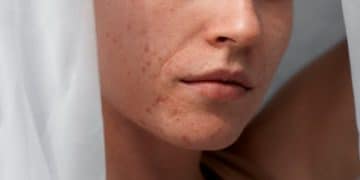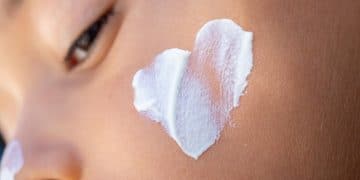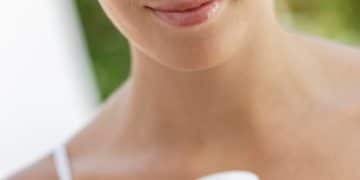How to Get Rid of Blackheads: A Comprehensive Guide
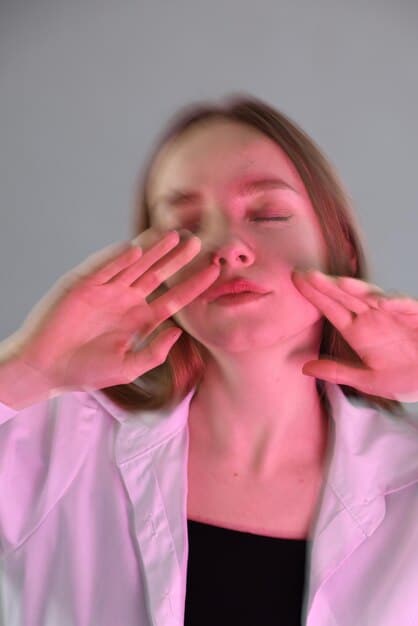
Anúncios
Blackheads, a common form of acne, result from clogged hair follicles trapping excess sebum and dead skin cells, appearing as small, dark spots primarily on the face and nose due to oxidation.
Navigating the complex world of skincare, especially when it comes to persistent issues like blackheads, can be a common challenge for many. This comprehensive guide, How to Get Rid of Blackheads: A Comprehensive Guide, aims to demystify these pesky skin concerns, offering actionable insights and evidence-based strategies to clear your complexion.
Understanding Blackheads: What They Are and Why They Form
Before diving into solutions, it’s crucial to understand what blackheads are. Known scientifically as open comedones, they are a mild form of acne that commonly appears on the face, particularly the nose, chin, and forehead, but can also occur on the back, chest, and arms. Unlike whiteheads, which are closed comedones, blackheads have open surfaces, exposing their contents to air, leading to oxidation and their characteristic dark color.
The primary culprit behind blackhead formation is the excessive production of sebum, the natural oil produced by our sebaceous glands. This excess sebum, combined with dead skin cells and sometimes bacteria, can clog hair follicles. When these clogged folliclesremain open to the air, the mixture within oxidizes, turning dark and creating the appearance of a blackhead. This process is entirely distinct from dirt, emphasizing that washing alone isn’t always the solution.
Factors Contributing to Blackhead Formation
Several factors can exacerbate the formation of blackheads. Hormonal fluctuations, common during puberty, menstruation, or pregnancy, can significantly increase sebum production. Genetics also play a role; if your parents were prone to blackheads or oily skin, you might be too. Additionally, certain medications, such as corticosteroids, lithium, or some anticonvulsants, can trigger or worsen acne, including blackheads.
- Hormonal Imbalances: Androgens, male hormones present in both sexes, stimulate sebaceous glands.
- Excess Sebum Production: Overactive sebaceous glands lead to more oil, increasing clogging potential.
- Dead Skin Cell Buildup: Inadequate exfoliation allows dead cells to accumulate and trap oil.
- Cosmetic Products: Comedogenic (pore-clogging) makeup and skincare can exacerbate the problem.
Beyond internal factors, external influences also contribute. High humidity and pollution can irritate the skin and promote clogging. Even certain dietary choices, though less directly linked, are sometimes considered by individuals to impact their skin condition. Understanding these underlying causes is the first step toward effective management and prevention, ensuring treatments address the root of the issue rather than just the symptoms.
Recognizing the specific triggers for your skin is key. Someone experiencing hormonal acne might benefit from different treatments than someone whose blackheads are primarily due to environmental factors or product misuse. This foundational knowledge empowers individuals to make informed decisions about their skincare routine, moving beyond generic advice to tailored solutions that truly work for their unique skin type and concerns.
Effective Skincare Regimens for Blackhead Removal
Once you understand blackheads, developing an effective skincare regimen becomes paramount. This isn’t just about using a single product; it’s about integrating multiple steps and ingredients that work synergistically to address the root causes and clear existing blockages. Consistency is key, as is patience, as results rarely appear overnight.
The cornerstone of any blackhead-fighting regimen revolves around cleansing, exfoliating, and treating. Regular cleansing removes surface impurities and excess oil. Exfoliation, whether chemical or physical, helps slough off dead skin cells that contribute to clogged pores. Treatment products often contain active ingredients specifically designed to dissolve clogs and regulate oil production.
Cleansing and Exfoliating Principles
A gentle yet thorough cleanser should be used twice daily to remove makeup, dirt, and excess oil without stripping the skin. Over-cleansing or using harsh products can irritate the skin, potentially worsening breakouts. Following cleansing, gentle exfoliation is vital. Chemical exfoliants, like Alpha Hydroxy Acids (AHAs) and Beta Hydroxy Acids (BHAs), are often preferred for blackheads.
- Salicylic Acid (BHA): Penetrates oil and exfoliates inside the pore, making it highly effective for blackheads.
- Glycolic Acid (AHA): Exfoliates the skin’s surface, helping to remove dead cells.
- Physical Exfoliants: Use with caution; choose finely milled scrubs and avoid harsh abrasive ones to prevent skin irritation.
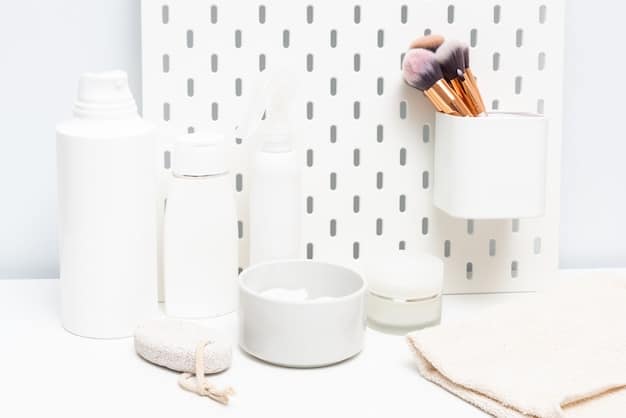
While physical exfoliants can provide immediate smoothness, their effectiveness for blackheads is limited, and aggressive scrubbing can damage the skin barrier. Chemical exfoliants, particularly those containing salicylic acid, work by dissolving the bonds between dead skin cells, allowing them to shed more easily and preventing pore blockages from forming in the first place. Introducing these active ingredients gradually into your routine is crucial, starting with lower concentrations and less frequent use to allow your skin to adjust.
Hydration is another often-overlooked aspect. Even oily skin needs moisture. Using a lightweight, non-comedogenic moisturizer helps maintain a healthy skin barrier and can prevent the skin from overproducing oil in response to dryness. Sun protection is also non-negotiable, especially when using exfoliating acids, as they can increase sun sensitivity. A broad-spectrum SPF 30 or higher should be applied daily.
Finally, avoid picking or squeezing blackheads. While tempting, this can push the contents deeper, lead to infection, or result in scarring and post-inflammatory hyperpigmentation. Professional extractions by a dermatologist or esthetician are safer alternatives if immediate removal is desired.
Advanced Treatments and Professional Interventions
When a consistent skincare routine isn’t enough, or for more pervasive blackhead issues, advanced treatments and professional interventions can offer more robust solutions. These options leverage specialized techniques and higher-strength ingredients to target stubborn blackheads and improve overall skin texture.
Professional treatments often provide a deeper level of exfoliation or extraction that is difficult to achieve at home, minimizing the risk of skin damage and infection. They are particularly beneficial for individuals with extensive blackheads or those who haven’t seen significant improvement with over-the-counter products.
Types of Professional Treatments
Dermatologists and trained estheticians offer several in-office procedures for blackhead removal and prevention:
- Manual Extractions: Performed by a professional using sterile tools, safely removing blackheads without damaging the surrounding skin.
- Microdermabrasion: A minimally invasive procedure that uses a specialized applicator to gently sand away the outer layer of skin, improving texture and reducing pore blockages.
- Chemical Peels: Involve applying a chemical solution to the skin to exfoliate and eventually peel off, revealing smoother, clearer skin underneath. Glycolic acid and salicylic acid peels are common for acne.
Beyond these, laser and light therapy can also be considered. While primarily used for inflammatory acne, some light treatments can help reduce oil production and improve skin tone, indirectly impacting blackhead formation. These treatments should always be discussed with a qualified professional to determine suitability and potential side effects.
It’s important to remember that professional treatments are not always a one-time fix. Many require a series of sessions to achieve optimal results and may need maintenance treatments. Combining professional procedures with a diligent at-home skincare routine is often the most effective strategy for long-term blackhead management.
Before undergoing any advanced treatment, a thorough consultation with a dermatologist is highly recommended. They can assess your skin type, the severity of your blackheads, and any underlying conditions to create a personalized treatment plan. This ensures both safety and efficacy, leading to clearer, healthier skin.
Diet, Lifestyle, and Blackhead Prevention
Addressing blackheads isn’t just about what you put on your skin; it’s also influenced by your internal health and daily habits. Focusing on diet and lifestyle can play a significant role in preventing blackhead formation and promoting overall skin well-being, complementing your topical treatments.
While the link between diet and acne is complex and individual, certain dietary patterns have been associated with increased oil production or inflammation, which can indirectly contribute to breakouts. Similarly, lifestyle choices, such as stress management and hygiene, are crucial for maintaining clear skin.
Dietary Considerations
Although no specific food directly causes blackheads, some individuals report skin improvements by modifying their diet. Foods with a high glycemic index, rapid blood sugar spikes, and dairy products are often discussed in relation to acne. However, scientific evidence remains debated and varies widely among individuals.
- Low Glycemic-Index Foods: Emphasize whole grains, fruits, vegetables, and lean proteins to stabilize blood sugar.
- Omega-3 Fatty Acids: Found in fish and flaxseed, they possess anti-inflammatory properties that may benefit skin health.
- Hydration: Drinking adequate water supports overall skin function, though its direct impact on blackheads isn’t specific.
Instead of rigid dietary restrictions, focus on a balanced, nutrient-rich diet. Pay attention to how your skin reacts to certain foods and adjust accordingly. Consulting a nutritionist or dietitian can provide personalized guidance regarding dietary influences on skin health.

Lifestyle Habits for Clearer Skin
Beyond diet, several lifestyle adjustments can significantly impact blackhead prevention. Stress, for example, can trigger hormonal fluctuations that lead to increased sebum production. Managing stress through activities like meditation, exercise, or hobbies can have a positive effect on your skin.
Hygiene practices are also essential. Regularly washing pillowcases, phone screens, and anything else that frequently touches your face can reduce the transfer of oils and bacteria. Avoid touching your face excessively throughout the day to prevent the spread of dirt and oil from your hands to your pores.
Choosing non-comedogenic products for makeup, sunscreen, and moisturizers is crucial. These products are formulated to avoid clogging pores. Always remove makeup thoroughly before bed, allowing your skin to breathe and regenerate overnight. Regular, moderate exercise also promotes healthy circulation, which can indirectly contribute to clearer skin by delivering nutrients and oxygen more efficiently.
Finally, adequate sleep is vital for skin repair and regeneration. During sleep, your body produces growth hormones that aid in cellular turnover and repair. Prioritizing 7-9 hours of quality sleep can significantly improve your skin’s ability to heal and maintain its health.
Common Mistakes to Avoid When Treating Blackheads
In the pursuit of clear skin, many individuals inadvertently make mistakes that can worsen blackheads or irritate their skin. Being aware of these pitfalls is just as important as knowing the right treatments, as avoiding them can prevent setbacks and ensure your efforts yield positive results.
One of the most common errors is over-treating or aggressively scrubbing the skin. While exfoliation is key, excessive or harsh methods can compromise the skin barrier, leading to increased sensitivity, redness, and even more breakouts. The goal is to gently assist the skin’s natural processes, not to forcefully strip it.
Mistakes in Product Selection and Application
Choosing the wrong products or misapplying them can severely hinder your progress. Not all skincare ingredients are created equal for blackhead treatment, and some can even be detrimental, especially if your skin is sensitive.
- Over-Exfoliating: Using too many exfoliating products (chemical or physical) or using them too frequently can damage the skin barrier, leading to irritation and inflammation.
- Using Comedogenic Products: Many makeup, sunscreen, and moisturizer formulas contain ingredients that can clog pores. Always look for “non-comedogenic” or “non-acnegenic” labels.
- Reliance on Pore Strips Alone: While satisfying in the short term, pore strips only remove the very top layer of oxidized sebum and don’t address the underlying cause or prevent new blackheads from forming.
Another frequently made mistake is neglecting hydration. Even oily and acne-prone skin needs moisture. When the skin is dry, it can overcompensate by producing more oil, creating a vicious cycle of oiliness and breakouts. Opt for lightweight, oil-free, and non-comedogenic moisturizers to support skin barrier function without clogging pores.
Consistency is also key, and inconsistency can be a mistake. Skincare regimens require time to show results. Jumping from one product to another too quickly, or not using products consistently, prevents the skin from adapting and seeing the full benefits of any treatment. Patience, typically 4-6 weeks for most products to show noticeable effects, is crucial.
Lastly, self-extraction without proper technique or tools is a significant pitfall. Squeezing or picking blackheads with bare fingers can push bacteria deeper into the pore, leading to inflammation, infection, and potential scarring. If extractions are necessary, seek a professional esthetician or dermatologist who can perform them safely and hygienically.
Debunking Blackhead Myths
The world of skincare is rife with myths, and blackhead treatment is no exception. Misinformation can lead to ineffective practices, wasted money, and even worsened skin conditions. Understanding and debunking these common myths is crucial for adopting an evidence-based approach to clear skin.
One prevalent myth is that blackheads are a sign of poor hygiene. This is inaccurate. As previously discussed, blackheads form due to a combination of excess sebum, dead skin cells, and open hair follicles that allow for oxidation. While clean skin is important for overall health, blackheads are primarily an internal skin process, not a surface dirt issue.
Common Misconceptions and Clarifications
Many believe they can “scrub away” blackheads with aggressive physical exfoliation. However, this is largely ineffective and often counterproductive. Harsh scrubbing can irritate the skin, disrupt its natural barrier, and potentially trigger more inflammation, leading to more breakouts or micro-tears.
- Myth: Blackheads are caused by dirt.
Reality: They are formed by oxidized sebum and dead skin cells, not external dirt. - Myth: Squeezing blackheads is the best way to remove them.
Reality: Self-extraction can cause damage, infection, and scarring; professional extraction is safer. - Myth: Pore strips permanently remove blackheads.
Reality: They only remove the top layer and do not prevent future formation or address the root cause.
Another common misconception is that hot water and steam can “open” pores to release blackheads. While steam can loosen skin and make extractions easier for professionals, pores do not “open” or “close” like windows. They are fixed structures. Excessive hot water can strip the skin of its natural oils, leading to dryness and irritation.
Some people also believe that certain foods, like chocolate or greasy foods, directly cause blackheads. While diet can influence skin health, the direct link between specific foods and blackheads is often oversimplified. Focus on a balanced diet rather than eliminating specific foods without evidence of a direct impact on your skin.
Lastly, the idea that tanning or sun exposure can clear blackheads is a dangerous myth. While a tan might temporarily mask the appearance of blackheads, UV radiation damages skin cells, increases oil production, and can worsen acne over time, not to mention the increased risk of skin cancer. Sun protection is always essential for skin health, especially when using active skincare ingredients.
Maintaining Blackhead-Free Skin Long Term
Achieving clear skin free of blackheads is a significant step, but maintaining that improved complexion requires ongoing commitment and strategic practices. It’s not about a quick fix but rather integrating a sustainable skincare routine and healthy habits into your daily life.
Consistency in your chosen skincare regimen is paramount. Even after blackheads clear, continuing with products that contain active ingredients like salicylic acid or retinoids helps prevent new blockages from forming. Regular, gentle exfoliation is key to ensuring dead skin cells don’t accumulate and clog pores again.
Strategic Skincare Adjustments
Your skin’s needs can change over time due to age, environment, or hormonal fluctuations. Therefore, it’s important to be flexible and willing to adjust your skincare routine as needed. What worked perfectly for your skin a year ago might not be the ideal solution today.
- Seasonal Adjustments: Skin tends to be drier in winter and oilier in summer; adjust moisturizer and cleanser accordingly.
- Ingredient Rotation: Consider alternating between different active ingredients (e.g., salicylic acid one night, retinoid another) to maximize benefits and minimize irritation.
- Listen to Your Skin: Pay attention to how your skin reacts to products and environmental factors. Adjust frequency or product type if irritation occurs.
Beyond topical treatments, reinforcing the healthy lifestyle choices discussed earlier is crucial for long-term prevention. Maintaining a balanced diet, managing stress effectively, ensuring adequate hydration, and getting enough quality sleep all contribute to a healthier skin barrier and balanced oil production, reducing the likelihood of blackhead recurrence.
Regular check-ups with a dermatologist or esthetician can also be highly beneficial for long-term maintenance. Professionals can assess your skin’s condition, recommend adjustments to your routine, and perform maintenance treatments like professional extractions or light peels as needed. This proactive approach helps nip potential issues in the bud before they become widespread problems.
Protecting your skin from environmental aggressors, particularly sun exposure, is also vital. Broad-spectrum SPF application every day, regardless of weather, not only prevents skin cancer but also helps protect against damage that can compromise skin barrier function and potentially contribute to acne issues. A holistic and consistent approach is truly the secret to keeping blackheads at bay for the long haul.
| Key Point | Brief Description |
|---|---|
| 💡 Understanding Blackheads | Caused by clogged pores, not dirt; involves oxidized sebum and dead skin cells. |
| 🧼 Effective Regimen | Consistent use of cleansers, exfoliants (Salicylic Acid), and non-comedogenic moisturizers. |
| 👩⚕️ Professional Help | For stubborn cases, consider extractions, microdermabrasion, or chemical peels from specialists. |
| 🛑 Avoid Mistakes | Don’t over-exfoliate, pick, or use comedogenic products; be patient and consistent. |
Frequently Asked Questions About Blackhead Removal
Blackheads form when hair follicles become clogged with excess sebum (oil) and dead skin cells. This mixture oxidizes upon exposure to air, leading to the characteristic dark appearance. Hormonal changes, certain medications, and genetics are common contributing factors, not primarily poor hygiene.
Self-extraction by squeezing blackheads is generally not recommended. It can push bacteria deeper into the pore, leading to inflammation, infection, and potential scarring. For safe removal, it’s best to consult a professional esthetician or dermatologist who can perform extractions using sterile tools and proper techniques.
The most effective ingredients for blackheads include Salicylic Acid (BHA), which penetrates oil to exfoliate inside the pores, and retinoids (like retinol or tretinoin), which promote cell turnover and prevent clogging. Alpha Hydroxy Acids (AHAs) like glycolic acid can also help by exfoliating the skin’s surface.
Pore strips can visibly remove the surface layer of oxidized sebum from blackheads, providing a satisfying immediate result. However, they are a temporary solution and do not address the underlying causes of blackhead formation. They don’t prevent new blackheads from appearing and can sometimes irritate sensitive skin.
Results vary depending on the severity of the blackheads and the consistency of your treatment regimen. Typically, noticeable improvements from consistent use of effective skincare products can be seen within 4 to 6 weeks. For stubborn cases, professional treatments might yield faster results but often require maintenance.
Conclusion
Effectively managing and getting rid of blackheads involves a multi-faceted approach, combining consistent skincare routines, awareness of dietary and lifestyle factors, and, when necessary, professional intervention. By incorporating key ingredients such as salicylic acid and retinoids, maintaining proper skin hygiene, and avoiding common mistakes like over-exfoliation or self-extraction, individuals can significantly improve their complexion. Understanding that blackheads are a natural skin occurrence, not a sign of poor hygiene, frees us to pursue informed and patient strategies. Ultimately, achieving and maintaining blackhead-free skin is a journey of consistency, adaptation, and a holistic approach to skin health, leading to lasting clarity and confidence.


